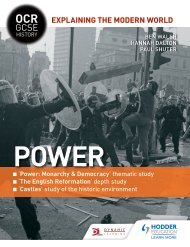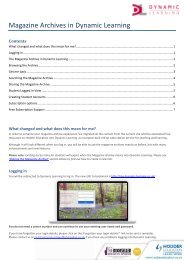GEOGRAPHY
WJEC-Eduqas-B-GCSE-Geography-sample-material
WJEC-Eduqas-B-GCSE-Geography-sample-material
You also want an ePaper? Increase the reach of your titles
YUMPU automatically turns print PDFs into web optimized ePapers that Google loves.
THEME 3 ENVIRONMENTAL CHALLENGES<br />
How do ecosystem processes<br />
operate within hot semi-arid<br />
grasslands?<br />
Within the hot semi-arid grassland ecosystem there are<br />
two main processes. These are the movement of energy<br />
(energy flows) and the recycling of nutrients.<br />
Energy flows<br />
The main source of energy for all living things is sunlight.<br />
This is absorbed by producers such as plants. They<br />
convert the light energy from the sun into chemical<br />
energy by the process of photosynthesis. This energy is<br />
passed on to animals when they eat the plants. These<br />
animals are called herbivores or primary consumers. In<br />
turn, these are eaten by other animals called carnivores<br />
or secondary consumers. This is called a food chain.<br />
Energy flows up the food chain.<br />
However, most producers and consumers are part of<br />
many different food chains. A food web shows the flow<br />
of energy through the whole ecosystem. A food web has<br />
many interconnecting food chains.<br />
Tertiary<br />
consumer<br />
Secondary<br />
consumer<br />
Primary<br />
consumer<br />
Producers<br />
Baboon<br />
Cheetah<br />
Rhinoceros<br />
Grasses<br />
Lion<br />
Giraffe<br />
Hyena<br />
Acacia Tree<br />
Figure 11 Food web for the hot semi-arid grassland<br />
ecosystem in Africa<br />
Nutrient cycling in the hot semi-arid<br />
grassland ecosystem<br />
Zebra<br />
As well as energy, plants need essential chemical<br />
elements and compounds such as iron, phosphate and<br />
nitrogen. These are called nutrients and they are recycled<br />
through the ecosystem between the soil, biomass and<br />
leaf litter. When plants and animals die, they decompose<br />
and the nutrients are released and returned to the soil.<br />
This process is called the nutrient cycle.<br />
Carnivores<br />
Tertiary consumers<br />
Secondary consumers<br />
Primary consumers<br />
Herbivores take in<br />
nutrients by eating plants<br />
Plants take up nutrients<br />
from the soil<br />
Animals die<br />
Waste such<br />
as animal<br />
dung<br />
Animals<br />
die<br />
Plants<br />
die<br />
Rock weathering<br />
adds some nutrients<br />
to the soil<br />
Figure 12 How nutrients are recycled<br />
Activity<br />
Decomposers<br />
such as bacteria<br />
and fungi,<br />
earthworms and<br />
dung beetles<br />
break down the<br />
dead plants and<br />
animals<br />
Leaf litter is the layer<br />
of vegetation on the<br />
ground surface<br />
Soil stores the nutrients<br />
Some nutrients lost by<br />
leaching and surface<br />
run-off when it rains<br />
1 a) Draw a food chain by putting the following<br />
into the correct sequence.<br />
lion grass energy from the sun zebra<br />
b) Explain the difference between a food chain<br />
and a food web.<br />
c) Draw a table like the one below and add<br />
examples from the hot semi-arid grassland<br />
food web in Figure 11.<br />
Biotic (living) part of the ecosystem<br />
Producer<br />
Primary consumer<br />
Secondary consumer<br />
Tertiary consumer<br />
Examples<br />
d) Explain why the hyena is both a secondary<br />
and tertiary consumer.<br />
e) What would be the effect on the hot semiarid<br />
grassland ecosystem if most of the lions<br />
were killed by people?<br />
2 a) Study Figure 12 Explain why nutrients are so<br />
important to the ecosystem.<br />
b) What role do decomposers play in the<br />
nutrient cycle?<br />
Recycled nutrients<br />
20




